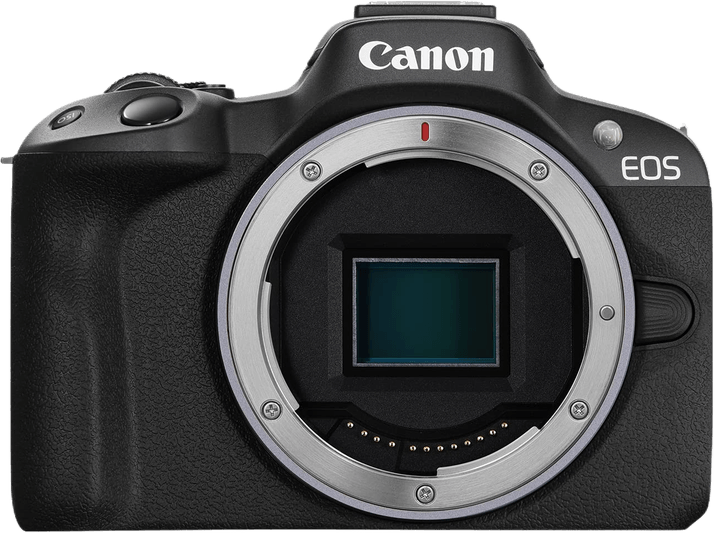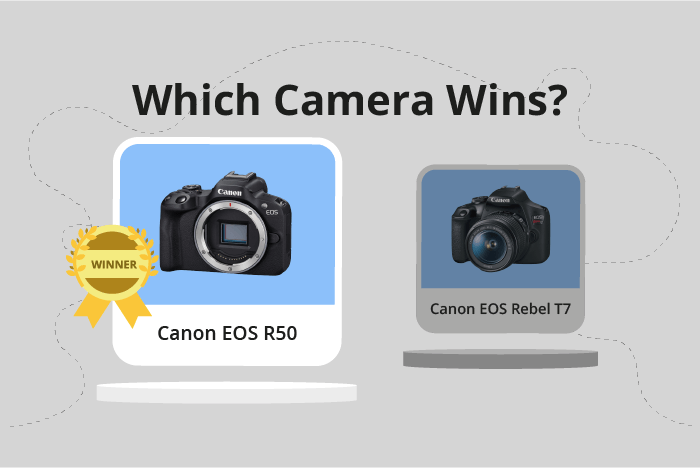Canon EOS R50 vs EOS Rebel T7 / 2000D Comparison
Canon EOS R50

Canon EOS Rebel T7 / 2000D

Comparing the Canon EOS R50 and Canon EOS Rebel T7/2000D, the R50 comes out as the winner, scoring 70 points, while the Rebel T7/2000D scores 50 points. Both cameras share the same brand and quality associated with Canon. However, they differ in camera type, with the R50 being a mirrorless camera and the Rebel T7/2000D being a DSLR.
The R50 outperforms the Rebel T7/2000D with its more compact size (116 x 86 x 69mm) and lighter weight (375g). Additionally, it is more recent, having been released in 2023, which could mean more advanced technology and features. On the other hand, the Rebel T7/2000D has a lower launch price of $550, making it more affordable for budget-conscious consumers.
Despite the R50’s higher score and advantages, the Rebel T7/2000D still has its merits, especially for those looking for a more wallet-friendly option. Ultimately, the choice between these two cameras depends on individual preferences and priorities, such as camera type, size, weight, and budget.
Canon EOS R50 vs EOS Rebel T7 / 2000D Overview and Optics
The Canon EOS R50 triumphs over the Canon EOS Rebel T7 / 2000D in optics with a score of 73/100, a 17-point difference from the T7’s 56/100. Both cameras share common specifications, including 24 and 24.1 megapixels, CMOS sensor type, APS-C sensor size, and lack of image stabilization. However, the R50 outperforms the T7 in several aspects.
The R50 has a faster shooting speed of 12 compared to the T7’s 3, enabling it to capture fast-moving subjects more effectively. Additionally, the R50 boasts a superior processor, the Digic X, which contributes to better overall image quality and faster performance. The R50 also has a higher DXOMARK score for the sensor at 94, compared to the T7’s 71, indicating a better sensor performance. Lastly, the R50 features a Canon RF lens mount, which grants access to a broader range of high-quality lenses.
In contrast, the T7 has a slightly higher megapixel count at 24.1, but this minor difference does not significantly impact image quality. The T7’s Canon EF-S lens mount is compatible with a wide variety of lenses, but it lacks access to the more advanced RF lenses available for the R50.
Taking these points into account, the R50’s superior shooting speed, processor, sensor performance, and lens compatibility make it the better choice for photographers seeking optimal optical performance. The T7, while still a capable camera, falls short in these areas and may not satisfy those looking for top-tier optics.
Canon EOS R50 vs EOS Rebel T7 / 2000D Video Performance
The Canon EOS R50 emerges as the clear winner in the video capabilities comparison, boasting a remarkable 91 out of 100 points, while the Canon EOS Rebel T7 / 2000D trails behind with a score of 43. Both cameras share some common video specifications, such as being able to record videos in H.264 format and having built-in mono microphones for audio recording.
The Canon EOS R50 outperforms the Rebel T7 / 2000D in several key aspects. Firstly, the R50 offers 4K video resolution with maximum dimensions of 3840 x 2160, while the Rebel T7 / 2000D only provides Full HD resolution at 1920 x 1080. Secondly, the R50’s maximum video frame rate reaches an impressive 120fps, significantly higher than the Rebel T7 / 2000D’s 30fps. Lastly, the R50 possesses built-in time-lapse functionality, a feature the Rebel T7 / 2000D lacks.
The Canon EOS Rebel T7 / 2000D, however, does have an advantage in terms of affordability, making it a more budget-friendly option for those who do not require advanced video capabilities.
Taking all these factors into account, the Canon EOS R50 is evidently the superior option for videographers seeking high-quality video features and performance. The 4K resolution, higher frame rate, and built-in time-lapse functionality make it a more versatile and powerful camera for capturing stunning videos. On the other hand, the Canon EOS Rebel T7 / 2000D is a more cost-effective choice for entry-level users who prioritize affordability over advanced video capabilities.
Canon EOS R50 vs EOS Rebel T7 / 2000D Features and Benefits
The Canon EOS R50 outperforms the Canon EOS Rebel T7 / 2000D with a feature score of 72/100 compared to 41/100. Both cameras share some common specifications, such as a 3-inch screen size, absence of GPS, and WIFI connectivity. However, the EOS R50 has additional advantages that contribute to its higher score.
The EOS R50 has a significantly higher screen resolution at 1,620,000 dots, compared to the Rebel T7’s 920,000 dots. This difference provides a clearer and more detailed display for the EOS R50. Additionally, the EOS R50 features a touchscreen, making it more user-friendly and efficient to navigate through menus and settings. Another advantage of the EOS R50 is its Bluetooth connectivity, which allows for seamless pairing with compatible devices for remote control and image transfer.
On the other hand, the Rebel T7 also has a flip screen, but lacks the touchscreen and Bluetooth capabilities of the EOS R50. Despite these shortcomings, the Rebel T7 may still appeal to those who prefer a simpler and more affordable camera option.
To sum up, the Canon EOS R50 offers superior features, such as a higher screen resolution, touchscreen interface, and Bluetooth connectivity. These advantages make it a more versatile and user-friendly camera than the Canon EOS Rebel T7 / 2000D. While the Rebel T7 may be a suitable choice for budget-conscious users or those who prefer a simpler interface, the EOS R50 is the clear winner in terms of features and overall performance.
Canon EOS R50 vs EOS Rebel T7 / 2000D Storage and Battery
The Canon EOS R50 wins in the storage and battery category with a score of 35/100, while the Canon EOS Rebel T7 / 2000D scores 27/100. Both cameras have one memory card slot and accept SD, SDHC, and SDXC memory cards. The R50 has an advantage as it is compatible with UHS-I and II cards, allowing for faster read and write speeds.
In terms of battery life, the Rebel T7 / 2000D outperforms the R50, offering 500 shots compared to the R50’s 370 shots. However, the R50 uses the LP-E17 battery type and supports USB charging, making it more convenient for on-the-go charging. The Rebel T7 / 2000D uses the LP-E10 battery type and lacks USB charging capabilities.
Despite the longer battery life of the Rebel T7 / 2000D, the Canon EOS R50’s compatibility with faster memory cards and USB charging feature make it a better choice in the storage and battery department.
Canon EOS R50 vs EOS Rebel T7 / 2000D – Our Verdict
Are you still undecided about which camera is right for you? Have a look at these popular comparisons that feature the Canon EOS R50 or the Canon EOS Rebel T7 / 2000D:

